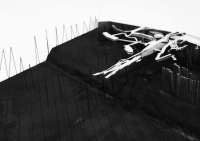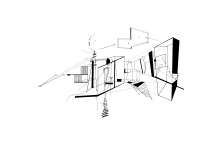Screenshot-2013-11-25-23.35.45.png
Screenshot-2013-11-25-23.35.56.png
Screenshot-2013-11-25-23.36.04.png
Screenshot-2013-11-25-23.36.11.png
Screenshot-2013-11-25-23.36.19.png
Screenshot-2013-11-25-23.36.26.png
Screenshot-2013-11-25-23.36.34.png
Screenshot-2013-11-25-23.36.40.png
Screenshot-2013-11-25-23.36.49.png
Screenshot-2013-11-25-23.36.56.png
Screenshot-2013-11-25-23.37.02.png
Screenshot-2013-11-25-23.37.09.png


An architectural provocation of the Socialistic country, Cuba. Research started from hitchhiking in Havana, mapping of the behaviors of individuals. With self-interpretation and experience leads to a speculative design of a Fish Auction Market in Havana.
the research_mapping of hitchhikers decodification of the rituals mapping of hitchhikers to fish auction market, havana Hitchhiking is an urban phenomenon in Havana. It appears in the main arteries of the infrastructure (junctions, roundabout, highway, bridges etc). Hitchhiking is invisibly shaping the daily influxes and out-fluxes within and out- side of the city. The underlying socio-political background is very complex. Such as the scarcity of cars, high diesel price, unreliable transportation and state control. The project itself emphasises on the contradiction of supply and demand in Havana. The research of hitchhikers divided into both urban and architectural scale. In the urban scale, it suggests a network of this social phenomenon by pointing out the hitchhiking points with higher probability. They are the points of entry and leave, i.e. exchange. While connecting these points with the speed and time that I personally had experienced, a new hitchhiking map is evolved. The whole exercise helps to understand the influx and out-flux pattern of com- muters. It also states the importance of hitchhiking in the country, otherwise the whole infrastructure/ transportation network will collapse. The new map also reformulates and allows us to perceive the city differently through travelling by the means of time and speed. To proceed further and understand this phenomenon, the design methodology is developed firstly by sampling four locations with distinctive conditions. The study correlates with the spatial experience and hitchhikers’ behaviour other than time/speed. Temporality is never able to be measured because it is continuous and indivisible. In order to analysis the set up and context, to unfold the each condition at a specific duration is essential. Although it is impos- sible to reveal absolute knowledge of hitchhiking, the sampling of conditions and collected information is sufficient to provide an essence of the hitchhiking system. Mapping in this project is a tool to unfold the social behaviours and the inscription of spatial quality within.
the design_FISH AUCTION MARKET is a combination of necessity and political mechanism. The proposal is to suggest a new way of consumption in Havana. It is a speculation of freedom to choose, to consume, to supply. Fishing is an essential activity for the Cubans. The daily harvest supplies food for families, it is free and depends on fisherman’s luck of the day.
By introducing auction market in Havana, a tension in between supply and demand becomes much more visible. Auction market itself is open and public. Within a time limit, participants have to bid for their demand goods. In the socialistic society, everything belongs to the state. Fisherman (similar to drivers) can choose not to sell their harvest. It is the novel form of ‘economy of scales’ that the program is suggesting.
An architectural provocation of the Socialistic country, Cuba. Research started from hitchhiking in Havana, mapping of the behaviors of individuals. With self-interpretation and experience leads to a speculative design of a Fish Auction Market in Havana.
the research_mapping of hitchhikers decodification of the rituals mapping of hitchhikers to fish auction market, havana Hitchhiking is an urban phenomenon in Havana. It appears in the main arteries of the infrastructure (junctions, roundabout, highway, bridges etc). Hitchhiking is invisibly shaping the daily influxes and out-fluxes within and out- side of the city. The underlying socio-political background is very complex. Such as the scarcity of cars, high diesel price, unreliable transportation and state control. The project itself emphasises on the contradiction of supply and demand in Havana. The research of hitchhikers divided into both urban and architectural scale. In the urban scale, it suggests a network of this social phenomenon by pointing out the hitchhiking points with higher probability. They are the points of entry and leave, i.e. exchange. While connecting these points with the speed and time that I personally had experienced, a new hitchhiking map is evolved. The whole exercise helps to understand the influx and out-flux pattern of com- muters. It also states the importance of hitchhiking in the country, otherwise the whole infrastructure/ transportation network will collapse. The new map also reformulates and allows us to perceive the city differently through travelling by the means of time and speed. To proceed further and understand this phenomenon, the design methodology is developed firstly by sampling four locations with distinctive conditions. The study correlates with the spatial experience and hitchhikers’ behaviour other than time/speed. Temporality is never able to be measured because it is continuous and indivisible. In order to analysis the set up and context, to unfold the each condition at a specific duration is essential. Although it is impos- sible to reveal absolute knowledge of hitchhiking, the sampling of conditions and collected information is sufficient to provide an essence of the hitchhiking system. Mapping in this project is a tool to unfold the social behaviours and the inscription of spatial quality within.
the design_FISH AUCTION MARKET is a combination of necessity and political mechanism. The proposal is to suggest a new way of consumption in Havana. It is a speculation of freedom to choose, to consume, to supply. Fishing is an essential activity for the Cubans. The daily harvest supplies food for families, it is free and depends on fisherman’s luck of the day.
By introducing auction market in Havana, a tension in between supply and demand becomes much more visible. Auction market itself is open and public. Within a time limit, participants have to bid for their demand goods. In the socialistic society, everything belongs to the state. Fisherman (similar to drivers) can choose not to sell their harvest. It is the novel form of ‘economy of scales’ that the program is suggesting.